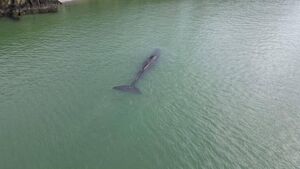Happy ending in the tale of the sperm whale spotted in Waterford Estuary

Sperm whale swimming in Waterford estuary on Tuesday. Photo: Damien Tiernan/Damien Burke on Facebook
“No news is good news” in the tale of the sperm whale sighted in Waterford Estuary last week.
There have been no sightings of the whale in Waterford waters since Tuesday, March 25.
Sightings Officer at the Irish Whale and Dolphin Group, Pádraig Whooley, told the Waterford News & Star that the fact that there have been no further sightings likely means the whale made it home.
He said that given how high profile the incident was and if the animal was stranded, someone would have reported it.
“In this instance, we'd be of the opinion that no news is good news,” said Mr Whooley.
According to a post on the IWDG website and written by Mr Whooley, the sperm whale was first reported at Bromwell Point at around 8:24am, on Tuesday.
Throughout the day, members of the public and those working on the water reported their sightings.
Because of this, we know the whale travelled toward Passage East and then headed back toward a shipping channel close to Duncannon.
The last sighting was 1.5 miles south of Red Head on the Waterford side of the estuary entrance.
The whale hasn’t been seen since.
Last week’s incident was described by the group as “an extremely unusual situation”.
Sperm whales are deep divers, and Mr Whooley said he would expect it to be 1000-2000 meters deep where its food source is located.
Since 1990 the IWDG have only recorded 27 live sightings of these animals.
“For it to be swimming in two meters of water, that is as close as you can get to a stranding,” said Mr Whooley.
So this was one lucky whale.
Sperm whales are the largest toothed whale on the planet.
According to the National Biodiversity Data Centre, citing the IWDG, the average male weighs 40 tonnes and is 20 meters in length.
The average female weighs 22 tonnes and is 11m in length.
They have a life expectancy of between 65 and 70 years.
Mr Whooley said there is no way for them to know for sure how the whale ended up in the estuary.
It could be that it was ill, and its ability to navigate might be compromised.
But the whale seemed to have found its way.
The tale of the sperm whale in Waterford was made possible because of reports by members of the public.
You can report a sighting to the Irish Whale and Dolphin Group through their website or on the mobile reporting app.
But remember, these are wild animals, and they need their space.
Those in boats should keep a distance of at least 100 metres, and that includes kayaks.
Ideally, if you want to watch whales, you should do so from the shore with binoculars.
The IWDG ask that the public maintain a respectful distance as these animals are highly protected and dangerous if stressed.






